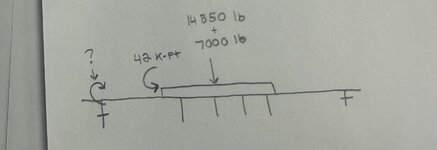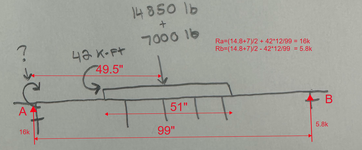In my last post, I misinterpreted your diagram.
I think you are considering a footing 99" long, loaded with 21,850# at its midpoint and a 42'k moment applied at the left end of the 51" plate. You have a question mark at the left end of the footing, pointing to a curved arrow which presumably represents a moment. Unless there is an applied moment or a support, there can't be a moment at that location. In that case, the footing must resist the vertical load P=21.85k and the moment M=42'k.
The location of the 42'k moment affects the bending moment and deflection of the footing, but if deflections are neglected, it does not affect the distribution of soil pressure.
I agree with your conclusion, but your reasoning is wrong. 42*2(SF) gives units of kip-ft^3, which is nonsense.
The usual procedure is to determine eccentricity = M/P = 42'k/21.85k = 1.92' = 23", so move the load P left by 23" and remove moment M = 42'k.
Since the eccentricity is within the 99" length of footing, overturning is not an issue, but the eccentricity exceeds 99/6 = 16.5" (half of the kern), which means that the effective length of footing is reduced from 99" to 3(99/2 - 23) = 79.5". If that is not clear, let me know.
Soil pressure will have an average value of 21,850/79.5 = 275 pounds/lineal foot, but because the load is acting at the kern of the footing, soil pressure varies from 0 to 2*275 = 550 pounds per lineal foot. If the footing has a width of w, the maximum soil pressure is 550/w psf.



